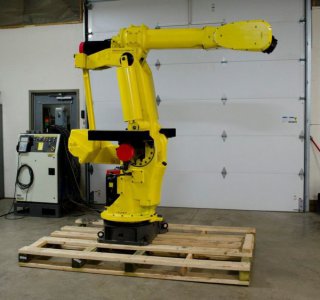- Joined
- Oct 29, 2012
- Messages
- 1,387
This is probably a dumb question, but I'll ask anyway...
Robots can mill steel apparently, as per this video:
And now that we have a mature robo-manufacturing industry, you can find used/refurbished industrial robotic systems for an astonishingly low price, for example:
1997 Fanuc S420IW for $3,800. Refurbished, complete, 100% working, and looks great.
http://www.ebay.com/itm/Fanuc-Robot...8140669&pid=100005&rk=2&rkt=6&sd=271770553090

Any reason why you couldn't put a milling head on that thing and have the world's most versatile milling (and plasma cutting, and welding, and painting, and dog walking, and hamburger cooking) machine, all for less than the price of a 3-axis CNC mill? Why not?
Like I said, dumb question; I am not all that knowledgeable about milling, and I know even less about robots. But I'd like to know what would stand in one's way of doing this. Is your typical 1997 model eBay robot not rigid enough for milling? is there no affordable software available to make it happen?
Robots can mill steel apparently, as per this video:
And now that we have a mature robo-manufacturing industry, you can find used/refurbished industrial robotic systems for an astonishingly low price, for example:
1997 Fanuc S420IW for $3,800. Refurbished, complete, 100% working, and looks great.
http://www.ebay.com/itm/Fanuc-Robot...8140669&pid=100005&rk=2&rkt=6&sd=271770553090

Any reason why you couldn't put a milling head on that thing and have the world's most versatile milling (and plasma cutting, and welding, and painting, and dog walking, and hamburger cooking) machine, all for less than the price of a 3-axis CNC mill? Why not?
Like I said, dumb question; I am not all that knowledgeable about milling, and I know even less about robots. But I'd like to know what would stand in one's way of doing this. Is your typical 1997 model eBay robot not rigid enough for milling? is there no affordable software available to make it happen?

 The CNC software should not be terribly expensive, Mach3 will run 6 axis.
The CNC software should not be terribly expensive, Mach3 will run 6 axis.